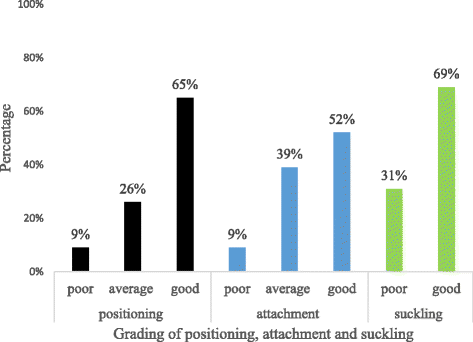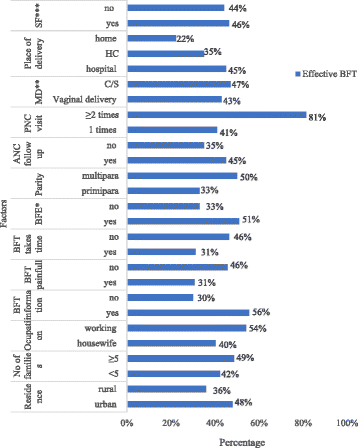Breastfeeding technique and associated factors among breastfeeding mothers in Harar city, Eastern Ethiopia
- PMID: 29434650
- PMCID: PMC5791732
- DOI: 10.1186/s13006-018-0147-z
Breastfeeding technique and associated factors among breastfeeding mothers in Harar city, Eastern Ethiopia
Abstract
Background: Ineffective breastfeeding technique is one of the factors contributing to mothers practicing non-exclusive breastfeeding. Inappropriate breastfeeding technique is the leading cause of nipple pain in Ethiopia, as in other countries. However, no studies have examined breastfeeding technique and associated factors in eastern Ethiopia. Therefore, this study was conducted with the aim of assessing breastfeeding technique and associated factors among breastfeeding mothers.
Method: We conducted an institution based cross-sectional study in selected governmental health facilities of Harar city, Eastern, Ethiopia, from January to February 2017. Systematic random sampling technique was used to select 422 study participants. Data were collected using pretested observational checklist and interviewer administered questionnaires containing sociodemographic, maternal and infant characteristics. The variables, positioning, attachment and suckling, were used to assess the outcome variable of breastfeeding technique. Descriptive, bivariate and multivariate logistic regression analysis was done to identify independent predictors of BFT after controlling for confounding variables.
Result: The proportion of mothers practicing an effective breastfeeding technique was 43.4% (179/412). Effective breastfeeding technique was 2.3 times more common among mothers with at least secondary school educational status compared to mothers with no formal education (Adjusted Odds Ratio [AOR] 2.3; 95% Confidence Interval [CI] 1.1, 3.9). The practice of effective breastfeeding technique was significantly associated with mothers who had immediate breastfeeding technique counseling after birth (AOR 1.7, 95% CI 1.1, 2.8) and at least two postnatal visits (AOR 5.9; 95% CI 2.1, 15.9) compared to one visit. Absence of breast problems and having previous breastfeeding experience were also associated with the likelihood of effective breastfeeding technique practice (AOR 4.0; 95% CI 1.4, 10.9) and (AOR 3.3; 95% CI 1.1, 10.7) respectively.
Conclusion: The practice of effective breastfeeding technique was low. Effective breastfeeding technique practice was associated with higher educational status, previous information about breastfeeding technique, previous breastfeeding experience, absence of breast problems, receiving breastfeeding technique counseling immediately after birth and at least two postnatal visits. Therefore; health services should provide education about effective breastfeeding techniques and ensure postnatal care for all women, particularly primipara.
Keywords: Attachment; Breastfeeding in Eastern Ethiopia; Breastfeeding technique; Positioning; Suckling.
Conflict of interest statement
GT (MSc. in maternity and Neonatal care in Nursing) - Lecturer at Haramaya university, College of Health and Medical Sciences, School of Nursing and Midwifery. FM (PhD. in public health) - Lecturer at Haramaya university, College of Health and Medical Sciences, School of Nursing and Midwifery. BG (PhD. in public health) - Lecturer at Haramaya University, College of Health and Medical Sciences, School of Nursing and Midwifery. KS (MSc. in clinical midwifery) - Lecturer at Haramaya University, College of Health and Medical Science, School of Nursing and Midwifery.Ethical clearance was obtained from Institute of Health Research Ethical Review Committee (IHRERC) of Haramaya University College of Health and Medical Sciences, School of Nursing and Midwifery, Ethiopia. Then formal letter of cooperation was written to Harari Regional Health Bureau and to each of selected governmental health institutions. Each study participant was adequately informed about the purpose, method, anticipated benefit and risk of the study. Written informed consent was obtained from study participants. Confidentiality and cultural norms of study participants were also maintained.Not applicable.The authors declare that they have no competing interests.Springer Nature remains neutral with regard to jurisdictional claims in published maps and institutional affiliations.
Figures


References
-
- Federal Ministry of Health . Integrated Management of Childhood Illness. Addis Ababa: Federal Ministry of Health; 2016.
-
- Neonatal Coordinating Group. Neonatology Clinical Guidelines King Edward Memorial/Princess Margaret Hospitals. NCCU Clinical Guideline; 2014. p. 3–5. Available at: http://www.kemh.health.wa.gov.au/services/nccu/guidelines/documents/Moni....
-
- Coca KP, Gamba MA, Silva RS, Abrão ACFV. Does breastfeeding position influence the onset of nipple trauma? Revista da Escola de Enfermagem University of São Paulo. 2009;43:442–448. - PubMed
LinkOut - more resources
Full Text Sources
Other Literature Sources

